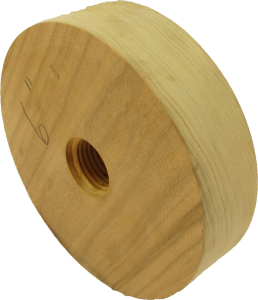Easy Wood Faceplates
 I’ve been using wood faceplates instead of metal faceplates with wood scrap blocks. A wood faceplate eliminates the risk of hitting a screw while turning. I can have as many wood faceplates as I want and keep it on the project until the project is complete. I can make any size faceplate that may be needed.
I’ve been using wood faceplates instead of metal faceplates with wood scrap blocks. A wood faceplate eliminates the risk of hitting a screw while turning. I can have as many wood faceplates as I want and keep it on the project until the project is complete. I can make any size faceplate that may be needed.
In a recent video making a segmented bracelet, I used two wood faceplates to build up the segment layers from both top and bottom at once. For that project I also used a reverse chucking alignment adapter to hold one faceplate in the tail stock with the other mounted in the head stock. With this mount, I was able to glue in the last middle layer to both at once on the lathe.
In this video, I turn a 6 inch wood faceplate.
- Mount a blank (poplar) on the face of a scroll chuck.
- Rough turn the blank to round and smooth the face.
- Cut a dovetail tenon.
- Flip the blank and mount to a chuck with the dovetail tenon.
- Bore the thread hole – 1 1/8″ in this case.
- Thread the hole – A Beall 1 1/4″ x 8 tpi tap
- Relieve hole 1/8 for the spindle base – on both sides. One the face so the faceplate can mount to the spindle in order to cut the relieve on the spindle side of the faceplate.
- Face off the chuck and it is ready for use.
I’ll still use metal faceplates for green bowl and large bowl turning. I like the safety of steel or aluminum in these cases.
Otherwise, I’m building my collection of faceplates.
Great idea, great video.
Hope you can put it to good use.
Thanks for watching
Alan Stratton
Alan, love all your tutorials and yes you have some great ideas
Great video – your videos are appreciated and useful.
Ray in AZ
Thank you for watching and commenting.
What project would you like to see?
Hi Alan
Really enjoyed your wooden face plate video, very clear and informative. I have one question: How do you normally fix the object you are going to turn onto the faceplate?
Cheers
Keith
For attaching to the faceplate,
I’ve used standard wood glue, CA glue, and hot melt glue. I may even try double stick tape although I’m less certain with this.
Thanks for watching.
Alan Stratton
Finally got around to watching this one, great minds think alike (g). I’ve been making my jam chucks and face plates of wood, and tapping them with a Beale tap, for a couple of years. I was using layers of Home Depot five ply, or 1″ (3/4) maple board. Discovered recently that a local hardwood specialist (Montieth)sells true boards of various widths and thickness by the board foot. I just used up my supply of 12/4 (3″) x 8″ poplar (they kindly cut me 48″ length off a 16′ board at no charge) that cost me about $20 dollars. As my lathe is a ‘midi’ (12″) with a 1″x8 spindle I need a hole depth of 1 1/2″ (including the unthreaded tip of the tap) – that leaves me 1 1/2″ beyond the threaded hole to work with.
Wow, a lot of detail you don’t need, but I write it for those others who love your videos and ideas who might have a smaller lathe. Fully agree on the poplar, a good hardwood that is not as expensive as most others. One doesn’t have to drill through the wood for the tap then add a layer – provided the wood is thick enough and the tap depth shallow enough.
As long as I’m rambling let me ask a question. Somewhere I read that the thread tapping was better, and more stable, if the tap was into the face grain rather than the end grain. I’ve followed that rule even though sometimes it means wasting a bit of wood when I have a scrap that I could use for a small faceplate. I’m all for experimenting, but not with things that might break away. What is your experience?
Best, Jon
Jon
I’ve read the same on tapping into facegrain. So, I’ve never tried end grain.
I suspect the reason is all the short grain risk.
I have had baltic birch plywood fail in face grain situations. These were nearly always when the wood diameter was small. So I don’t trust plywood anymore unless its diameter is greater than 6 inches. Even then I may drive dowels to reinforce the glue joints.
Tapping into a blind hole is technically superior. However, I don’t mind tapping on thru a 2″ piece. If then the working surface is small, I’ll glue on another layer. Often what I’m mounting to the faceplate is larger than the 1.25″ hole in the middle.
Cheers.
Alan
Hi Alan, I am coming across this very informative video late in life. Curiosity of having such things in the past helped me today to know nice things are made. You have a store of wealth in your knowledge and surely many shall benefit. Keep it up and best wishes for the future.
Thank you for your kind thoughts.
Sounds like you have a wealth of experience.
Anything you’d like to suggest?
Alan
Alan Once again great idea Please keep them coming,
Thanks I’m still in the very young learning curve for my new interest working with woods.
Sam